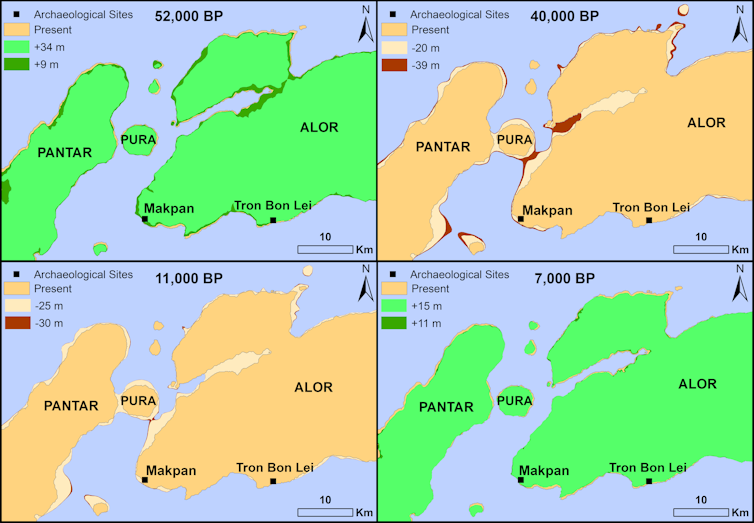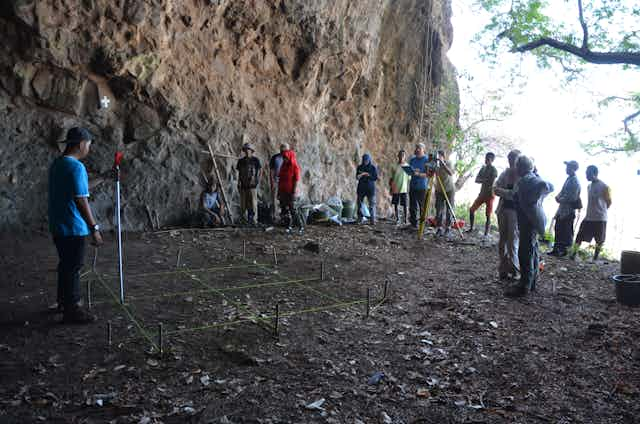As humans, our greatest evolutionary advantage has always been our ability to adapt and innovate. When people first reached the expanded coastline of Southeast Asia around 65,000 years ago, and faced the sea crossings necessary to continue east into the islands of the Wallacean archipelago (the migration of Homo sapiens out of Africa to Australia), these abilities were put to use like never before.
Our study reports new evidence that humans reached and settled on the island of Alor, East Nusa Tenggara, around 43,000 years ago.
Alor is a smaller island lying between the larger islands of Flores and Timor, on the southern migratory pathway between mainland Southeast Asia and Australia.
Traces of settlements from that time demonstrate that once people began to move into the islands, they did so very quickly, and rapidly adjusted to their new island homes, especially in terms of acquiring food.
Life traces in Makpan Cave
Our collaborative research project, involving Australian and Indonesian archaeologists, excavated Makpan cave on Alor’s south-west coast in mid-2016.

We identified the presence of human occupants in Makpan cave by discovering various tools made from stone, shell, and coral, as well as the remains of marine shell and sea urchins, for which humans are the only likely transport agents from coast to cave.
We used radiocarbon dating of preserved charcoal and marine shell to determine the period of human occupation at Makpan. The presence of both these materials in the cave is a direct result of human activity, so their dates can be directly connected to when people were living at Makpan.
The Makpan dates push back the record for human occupation on Alor island, doubling the initial occupation date of 21,000 years previously recovered from Tron Bon Lei, excavated in 2014.

This new find shows that Alor was occupied at the same time as Flores to the west, and Timor to the east – confirming Alor’s position as a ‘stepping-stone’ between these two larger islands.
The deepest levels of the Makpan deposit recovered evidence for human occupation (such as stone tools and food waste) but in very low numbers. This suggests that when people first arrived at Makpan, they did so in low numbers.
During the 43,000 years of human occupation, Makpan witnessed a series of significant rises and falls in sea levels. This was caused by extreme climate changes during the last ice age. These environmental changes led the inhabitants of Makpan cave to undergo several phases of adaptation to environmental changes.
1. Early habitation phase
During the period from 43,000 to 14,000 years ago, when sea levels were lower, the inhabitants of Makpan relied more on coastal resources as they were more easily accessible.
During the Late Pleistocene (ice age), the lower sea level meant Alor Island was still connected to Pantar Island to the west. This created a mega-island that was nearly twice its size.
This condition eliminated the Pantar Strait between Pantar and Alor. The Pantar Strait is a passage for strong ocean currents connecting the Flores and Savu seas. Instead, the strait was replaced by a large sheltered bay.
Falling sea levels as the last ice age reached its maximum extent, also increased the distance from the site of Makpan to the coast.
This increased distance likely encouraged people to broaden their diet away from an intensely marine focus, to include a variety of land-based fruits and vegetables and perhaps make more use of giant rats, which were the only terrestrial fauna of any size available on the island at this time. This scenario is supported by isotopic analysis of human teeth from Makpan.

2. Pleistocene-Holocene transition phase
As the ice age began to wane around 14,000 years ago (the transition period from the Pleistocene to the early Holocene), bringing Makpan back within less than 1km of the coast, we see evidence for increased use of marine resources and foraging in the sheltered bay region, rocky coastline, reefs and deeper waters off Alor’s south coast.
This increased access to a variety of marine protein sources is represented by the veritable smorgasbord of seafoods forming the dense midden deposits between around 12,000–11,000 years ago.
It is no surprise that the site sees significant evidence for fishing at this time, not just the bones of a wide variety of fish and shark species, but also in the form of shell fishhooks in different shapes and sizes. It also has the other items needed for fishing such as sinkers, and files made of coral used to make the hooks. The hooks were made from highly nacreous (i.e. shiny) shell species – which may have assisted in attracting the fish.
Although we do not find perishable organic materials, the diversity of fish hook types found in Makpan implies the use of fibre lines and nets, and the ability to fish in both shallow and deep water.

3. Late habitation phase
As sea levels continued to rise in the Early-Middle Holocene, the Pantar Strait opened up once more and we see the loss of the sheltered bay resources from the Makpan diet alongside an increase in reliance on terrestrial foods.
This coincided with a decline in occupation intensity, culminating in the abandonment of Makpan about 7,000 years ago. Why Makpan was abandoned at this time we do not know. Perhaps these final sea level increases made other areas around Alor island more attractive settlement locations, encouraging people to re-locate.
The cave was reoccupied in the Neolithic (around 3500 years ago), after sea-levels had stabilised, and we see a significant change in technology and lifestyle - evidenced by the appearance of pottery and domestic animals in the deposits. The Makpan archaeological record shows just how inventive and adaptive modern humans were in response to global climate change.


